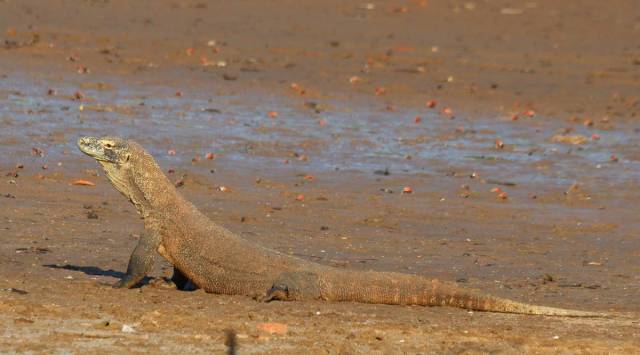Rising global temperatures likely to impact Komodo dragon populations: Ecologist Tim Jessop
The rise in sea level is expected to reduce the habitat of Komodo dragons, which have been moved from vulnerable to endangered on the IUCN Red List, by at least 30 per cent in the next 45 years.
 According to IUCN, sea level rise is expected to reduce habitat of Komodo dragon by at least 30% in the next 45 years. (Wikimedia Commons)
According to IUCN, sea level rise is expected to reduce habitat of Komodo dragon by at least 30% in the next 45 years. (Wikimedia Commons)Last week, the International Union for Conservation of Nature (IUCN) moved the Komodo dragon (Varanus komodoensis) from vulnerable to endangered on the IUCN Red List.
Endemic to Indonesia, the species is threatened by the impacts of climate change and, according to IUCN, the rise in sea level is expected to reduce their habitat by at least 30 per cent in the next 45 years.
The Komodo dragon, the world’s largest lizard, is now listed as #Endangered according to the latest @IUCNRedList, released at #IUCNcongress. Rising sea levels caused by #ClimateChange are a major threat https://t.co/K6AVvzhMHY pic.twitter.com/ImeJaiJFV2
— IUCN (@IUCN) September 4, 2021
Dr. Tim Jessop, a member of the IUCN Species Survival Commission (SSC) Monitor Lizard Specialist Group, explains to The Indian Express about the change in status of Komodo dragon.
What are the current threats to the species?
Komodo dragons remain reasonably well-protected, with nearly half of their distribution located inside protected areas, including the world-famous Komodo National Park. However, Flores Island in Eastern Indonesia, which sits adjacent to Komodo National Parks, has much less protection, allowing ongoing human expansion to reduce Komodo dragon habitats.
Like many tropical island endemics, increased global temperatures are predicted to either directly (e.g. reduce daily activity) or indirectly (e.g. changes in vegetation that influence Komodo dragon prey) impact island Komodo dragon populations.
These potential impacts could occur well before any sea-level rise leads to the flooding of low-lying coastal valleys that currently offer good habitat for this species.
Can you detail the current conservation strategies and what future initiatives are needed?
Komodo dragons, unlike most species, have been afforded informal and formal protection for over a century.
The most important and successful initiative was the Indonesian government’s establishment of Komodo National Park in 1980 (now a world heritage area). This national park has unquestionably provided an extremely important refuge for this species — protecting it against contemporary and hopefully future global change.
The most important future conservation initiatives could include ensuring the current protected area network remains well maintained.
Second, expanding protected areas into any substantial remaining unprotected climate-resilient habitats could also benefit Komodo dragons. This second initiative would require a dramatic investment in sustainable poverty abatement and community conservation initiatives across future protected areas to ensure local communities are not adversely impacted and promote the success of this conservation action.
Fun fact: Did you know Komodo dragons, as babies, have the most amazingly colourful skins with bright orange spots and white and yellow stripes that help camouflage them as they move about on treetops to seek food and avoid being eaten by other larger Komodo dragons that live on the ground.







